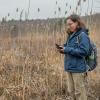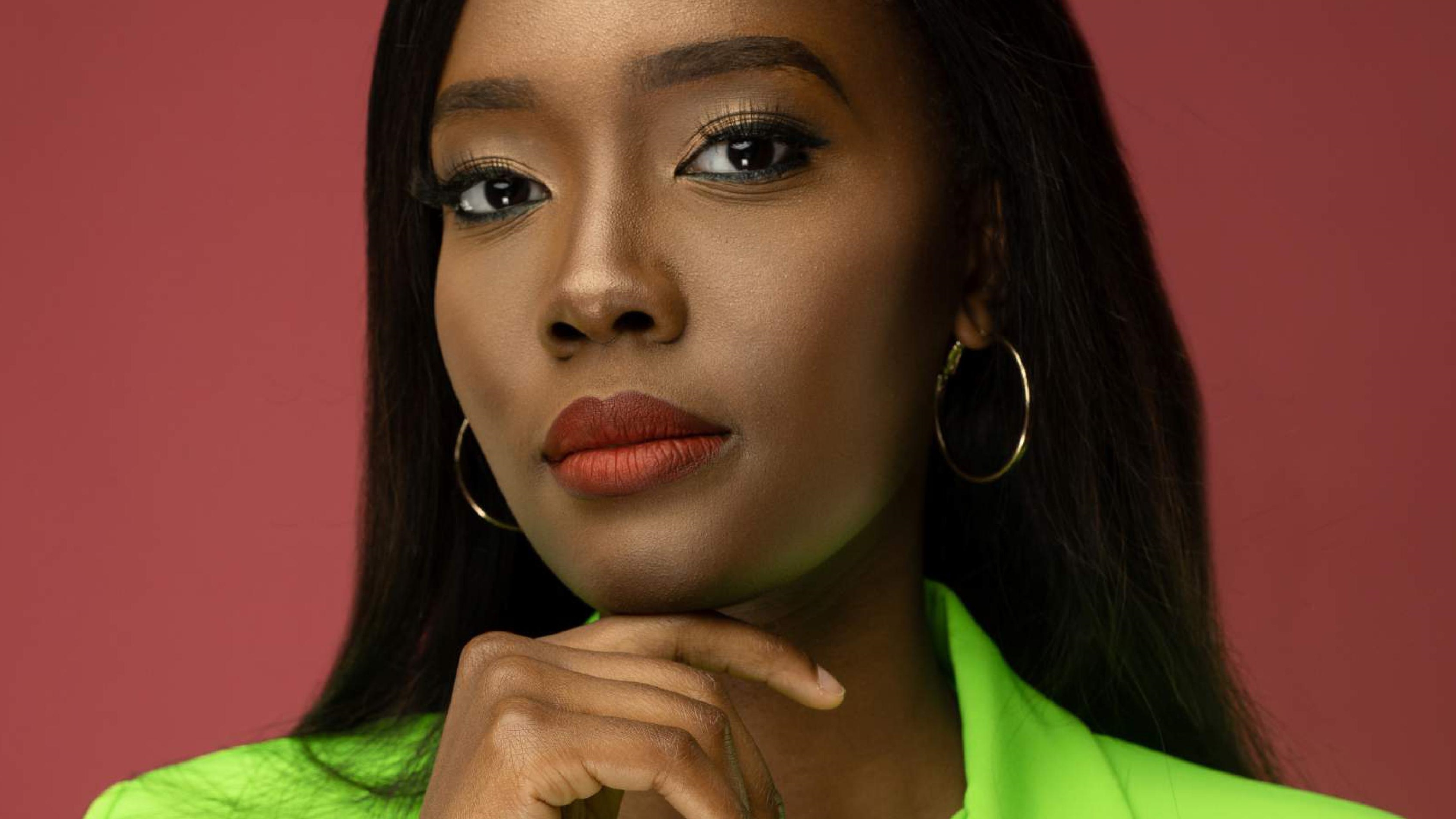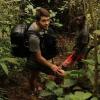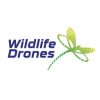With new technologies revolutionizing data collection, wildlife researchers are becoming increasingly able to collect data at much higher volumes than ever before. Now we are facing the challenges of putting this information to use, bringing the science of big data into the conservation arena. With the help of machine learning tools, this area holds immense potential for conservation practices. The applications range from online trafficking alerts to species-specific early warning systems to efficient movement and biodiversity monitoring and beyond.
However, the process of building effective machine learning tools depends upon large amounts of standardized training data, and conservationists currently lack an established system for standardization. How to best develop such a system and incentivize data sharing are questions at the forefront of this work. There are currently multiple AI-based conservation initiatives, including Wildlife Insights and WildBook, that are pioneering applications on this front.
This group is the perfect place to ask all your AI-related questions, no matter your skill level or previous familiarity! You'll find resources, meet other members with similar questions and experts who can answer them, and engage in exciting collaborative opportunities together.
Just getting started with AI in conservation? Check out our introduction tutorial, How Do I Train My First Machine Learning Model? with Daniel Situnayake, and our Virtual Meetup on Big Data. If you're coming from the more technical side of AI/ML, Sara Beery runs an AI for Conservation slack channel that might be of interest. Message her for an invite.
Header Image: Dr Claire Burke / @CBurkeSci

Explore the Basics: AI
Understanding the possibilities for incorporating new technology into your work can feel overwhelming. With so many tools available, so many resources to keep up with, and so many innovative projects happening around the world and in our community, it's easy to lose sight of how and why these new technologies matter, and how they can be practically applied to your projects.
Machine learning has huge potential in conservation tech, and its applications are growing every day! But the tradeoff of that potential is a big learning curve - or so it seems to those starting out with this powerful tool!
To help you explore the potential of AI (and prepare for some of our upcoming AI-themed events!), we've compiled simple, key resources, conversations, and videos to highlight the possibilities:
Three Resources for Beginners:
- Everything I know about Machine Learning and Camera Traps, Dan Morris | Resource library, camera traps, machine learning
- Using Computer Vision to Protect Endangered Species, Kasim Rafiq | Machine learning, data analysis, big cats
- Resource: WildID | WildID
Three Forum Threads for Beginners:
- I made an open-source tool to help you sort camera trap images | Petar Gyurov, Camera Traps
- Batch / Automated Cloud Processing | Chris Nicolas, Acoustic Monitoring
- Looking for help with camera trapping for Jaguars: Software for species ID and database building | Carmina Gutierrez, AI for Conservation
Three Tutorials for Beginners:
- How do I get started using machine learning for my camera traps? | Sara Beery, Tech Tutors
- How do I train my first machine learning model? | Daniel Situnayake, Tech Tutors
- Big Data in Conservation | Dave Thau, Dan Morris, Sarah Davidson, Virtual Meetups
Want to know more about AI, or have your specific machine learning questions answered by experts in the WILDLABS community? Make sure you join the conversation in our AI for Conservation group!
- @claudlacroix
- | she/her
PhD fellow using deep learning to investigate marine fish acoustic signals and social behaviour.
- 0 Resources
- 0 Discussions
- 4 Groups
GreenLab

- 0 Resources
- 19 Discussions
- 8 Groups
- 0 Resources
- 0 Discussions
- 2 Groups
Over 35 years of experience in biodiversity conservation worldwide, largely focused on forests, rewilding and conservation technology. I run my own business assisting nonprofits and agencies in the conservation community


- 0 Resources
- 22 Discussions
- 11 Groups
- @fsanger
- | she / her/ ella
- 0 Resources
- 4 Discussions
- 7 Groups
- @jcturn3
- | He/Him
Colorado State University
I am a graduate student at Colorado State University working to develop novel acoustic technology for remotely monitoring wildlife.
- 0 Resources
- 6 Discussions
- 3 Groups
- @roxirisa
- | roxi
Biologist I consider myself a data scientist with a passion for nature and with an extensive experience in species distribution modeling, handling large data sets from different sources such as gbif, eBird, xeno-canto, Worldclim, Terraclimate, ocean color e NASA among others. But
- 0 Resources
- 0 Discussions
- 9 Groups
Environmentalist and Python developer working in the realm of Remote Sensing. Fascinated by the intersection of technology and nature, with a focus on machine learning, ecological modeling, and biodiversity monitoring. 🌍
- 0 Resources
- 0 Discussions
- 11 Groups
- 0 Resources
- 0 Discussions
- 2 Groups
- 0 Resources
- 0 Discussions
- 1 Groups
- 0 Resources
- 0 Discussions
- 3 Groups
- @Namitha
- | She/her
Physics PhD candidate enthusiastic about conservation and ecology
- 0 Resources
- 0 Discussions
- 1 Groups
Join the Seeed Vision Challenge, an opportunity for conservation innovators to harness the power of AI vision sensors for environmental monitoring and protection.
10 April 2024
Full-Stack Software Developer (Python/React) - Specializing in AI/ML for Wildlife Conservation
5 April 2024
Article
Article from Ars Technica about how difficult it is to detect and avoid kangaroos...
3 April 2024
18 month postdoc research position, Netherlands, EU-funded
28 March 2024
Article
You’re invited to the WILDLABS Variety Hour, a monthly event that connects you to conservation tech's most exciting projects, research, and ideas. We can't wait to bring you a whole new season of speakers and...
22 March 2024
Join our multi-national team at the AI for Biodiversity Change Global Climate Center! We're hiring a Research Data Manager & Tech Coordinator at Ohio State. Support cutting-edge research on climate change &...
15 March 2024
Catch up on the conservation tech discussions and events that happened during World Wildlife Day 2024!
7 March 2024
EcoAssist introduces a free African species identification model for camera trap images, capable of recognising 30 species.
5 March 2024
Join us to help prevent biodiversity loss! Understory is hiring a postdoc to lead R&D Development on generalizing Computer Vision models for vegetation identification across space/time/phenotypes.
29 February 2024
Join the Luxembourg Institute of Science and Technology (LIST) in pioneering environmental and ecological monitoring! 🌍💡 As part of ERIN’s Observatory for Climate, Environment, and Biodiversity (OCEB), you'll be at the...
26 February 2024
SNTech are recruiting for 3 roles to assist us to develop computer vision pipelines for underwater monitoring
15 February 2024
We invite applications for the third Computer Vision for Ecology (CV4E) workshop, a three-week hands-on intensive course in CV targeted at graduate students, postdocs, early faculty, and junior researchers in Ecology...
12 February 2024
April 2024
event
October 2024
November 2023
event
event
event
| Description | Activity | Replies | Groups | Updated |
|---|---|---|---|---|
| It's fun having these start running in the forests! |
|
Autonomous Camera Traps for Insects, AI for Conservation, Emerging Tech, Open Source Solutions | 3 hours 50 minutes ago | |
| Hi Matthew,Thanks for your advice, this is really helpful!I'm planning to use it in a seagrass meadow survey for a series of ~20 drops/sites to around 30 m, recording for around... |
|
Acoustics, AI for Conservation, Data management and processing tools, Emerging Tech, Sustainable Fishing Challenges | 1 day 13 hours ago | |
| Hi Johnathan!Here are a few examples where UAVs and AI has been used to spot animals. https://www.mdpi.com/2504-446X/7/3/179#:~:text=These%20vehicles%20follow%20flight%... |
|
AI for Conservation | 2 days 1 hour ago | |
| Super great to see that there will be more work on insect ecoacoustics! So prevalent in practically every soundscape, but so often over-looked. Can't wait to follow this project... |
|
Acoustics, AI for Conservation | 3 days 23 hours ago | |
| Happy to explain for sure. By Timelapse I mean images taken every 15 minutes, and sometimes the same seals (anywhere from 1 to 70 individuals) were in the image for many... |
|
AI for Conservation, Camera Traps, Open Source Solutions, Software and Mobile Apps | 6 days 16 hours ago | |
| Greetings Everyone, We are so excited to share details of our WILDLABS AWARDS project "Enhancing Pollinator Conservation through Deep... |
|
AI for Conservation, Autonomous Camera Traps for Insects | 1 week 2 days ago | |
| EcoAssist is an application designed to streamline the work of ecologists dealing with camera trap images. It’s an AI platform that... |
|
Software and Mobile Apps, AI for Conservation, Camera Traps | 1 week 6 days ago | |
| We could always use more contributors in open source projects. In most open source companies Red Hat, Anaconda, Red Hat and Mozilla, people often ended up getting hired largely... |
|
Acoustics, AI for Conservation, Conservation Tech Training and Education, Early Career, Marine Conservation | 3 weeks 1 day ago | |
| Hi @timbirdweather I've now got them up and running and winding how I can provide feedback on species ID to improve the accuracy over time. It would be really powerful to have a... |
|
Acoustics, AI for Conservation, Citizen Science, Emerging Tech | 4 weeks 2 days ago | |
| Really interesting project. Interesting chip set you found. With up to around 2mb sram that’s quite a high memory for a ultra low power soc I think.It might also be... |
+8
|
Acoustics, AI for Conservation | 1 month 1 week ago | |
| Absolutely! I pretty much do the same thing, the resizing step I think relates to what I still have to do. Some large images caused my code to crash.I want to take it one step... |
|
AI for Conservation | 1 month 2 weeks ago | |
| This is great, thank you so much @zhongqimiao ! I will check it out and looking forward for the upcoming tutorial! |
|
AI for Conservation, Camera Traps, Open Source Solutions | 1 month 2 weeks ago |
Innovation wanted: Technology Testing to Mitigate Human-Elephant Conflict in West Bengal
19 June 2023 10:54pm
The Wildlife Society Conference
19 June 2023 5:59am
Catch up with The Variety Hour: June 2023
16 June 2023 11:43am
AI Prompt Engineer in Dublin, DGB Group
15 June 2023 3:32pm
CV4Animals: Computer Vision for Animal Behavior Tracking and Modeling
15 June 2023 12:39pm
FathomNet Workshop @CVPR 2023
15 June 2023 12:27pm
Apply for the Google for Startups Accelerator: Climate Change Middle East & Africa Program
9 June 2023 1:54pm
Celebrating World Oceans Day: Revitalizing the marine ecosystem with technology-driven engineered reefs to accelerate CO2 capture
9 June 2023 10:14am
As we celebrate World Oceans Day this month, we are reminded that addressing climate change will take more than any one organization. It will require companies, governments, NGOs and communities, all working together, with the aid of technology, to improve the efficiencies of our activities and operations and to reduce costs, waste and emissions. Such an example is IBM and The Reef Company recently joining forces signing a joint initiative agreement aimed at bolstering their ocean conservation endeavors.
Imageomics Institute Image Datapalooza, August 2023
2 June 2023 11:44pm
ISO Speakers for Emerging Technologies class.
31 May 2023 4:29pm
2 June 2023 2:08pm
Carly, that would be great! Thanks! I work with soundscapes and love the work of Rainforest Connection! I'll send you an email (@CUNY) to coordinate!
10 AI for the Planet Projects you should be excited about
25 May 2023 11:07am
Looking for AI volunteer positions
24 May 2023 5:41am
24 May 2023 3:45pm
Hi Donya! You might check out the Conservation Tech Directory to see what projects/organizations/tools best align with your interests and skills.
Director of Research
Mbaza AI recognized by UNESCO & new team member
17 May 2023 8:49pm
Happywhale: AI-Powered Whale Identification
 Happywhale
Happywhale
16 May 2023 10:00am
Lecturer/Associate Professor of Ecology and Innovative Technologies
 UCL
UCL
16 May 2023 9:25am
Deadline Approaching: Conservation Tech Award
15 May 2023 10:21pm
Photo Quadrats, AI, and MERMAID: A Case Study from Mozambique
12 May 2023 3:44pm
AI for Conservation Office Hours: 2023 Review
 Jake Burton
Jake Burton
11 May 2023 10:00am
Crowdsourcing individual ID for pop dyn?
1 May 2023 5:36pm
5 May 2023 6:15pm
That sounds like a really neat project! Do fish get re-caught often enough that individual ID is useful? Is sample bias (more data from popular spots) an issue?
GRO is the story of what on Earth is going on
5 May 2023 1:50pm
Using computer vision to understand bee vision
5 May 2023 1:10am
Here's an innovative project from the Harvey Mudd College Bee Lab that could help us understand how bees view their environments, and thus better protect bee habitat. This project uses computer vision and drone imagery to replicate "bee vision" of flowers and how it differs from a human's view of the same habitat.
How can you tell if a photo is AI generated? Here are some tips.
29 April 2023 3:35pm
[Recordings Now Available!) EarthRanger User Conference
27 April 2023 5:52am
Looking to contribute
27 April 2023 2:41am
Artificial Intelligence and Conservation: Closing Session
26 April 2023 8:54pm
Artificial Intelligence and Conservation with Lily Xu
26 April 2023 8:41pm
WWF's recent Fuller Seminar Series on Artificial Intelligence and Conservation featured some familiar faces from the WILDLABS community, including our past Tech Tutor Lily Xu! Check out her presentation talking about AI-based causal reasoning and how it can be applied to conservation challenges.
AI Animal Identification Models
30 March 2023 5:01am
20 April 2023 12:53am
Thanks Dan, that is very helpful. No zebras here but I did see four deer wandering through the streets this morning. Quite wild at times here!
I am totally willing to try an image classifier if it reports multiple objects it identifies in a scene. I will give this a go.
I think 1 fps would be quite acceptable actually, and in some perspective actually advantageous in reducing how much data is getting logged.
I tried upgrading my existing object detector model to YOLOv8 following the links you sent, but I don't think it is possible to upgrade the model on the framework I'm using (ml5js) so I think I will have to try a different framework.
Thank you.
25 April 2023 2:08pm
Hi David
It appears that you have been looking for existing models, however, most existing models are trained on either COCO or some other very generic dataset. So, if you want to identify just animals, you may be better off training your own model. It seems no one in this thread mentioned yet that it is possible to do transfer learning on existing models, which keeps most of the "visual part" of the model as is, but just changes the classification part so it can identify other things. This way you can take an existing model trained on COCO and in a fraction of the time it takes to train a full model, just retrain that for your animals.
Also have a look at your requirements for the inferencing stage. Some models take long in training but are superfast in inference and others are slow in both cases but very accurate, etc. If you want semi-realtime inferencing, you are probably looking at single shot detectors (SSD), and not RCNNs.
26 April 2023 7:34pm
Thanks Bas! I'll look into SSD vs RCNNs, I'd never heard of an SSD.






















































31 May 2023 10:21pm
Definitely interested! I'm in the ecoacoustics/acoustic monitoring space, working at Rainforest Connection and Arbimon.